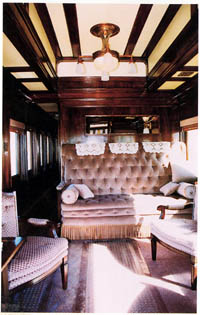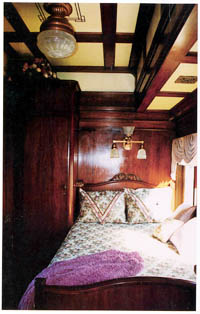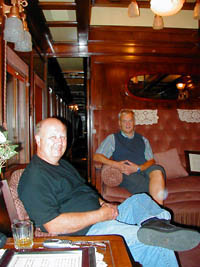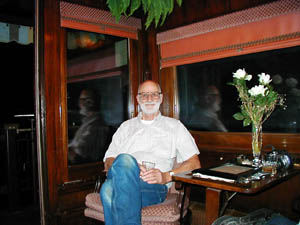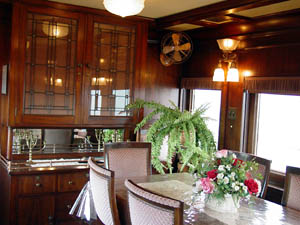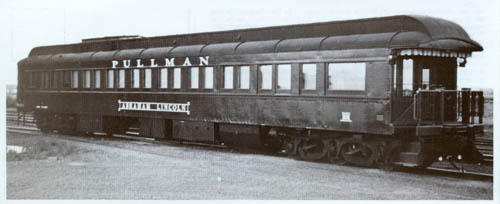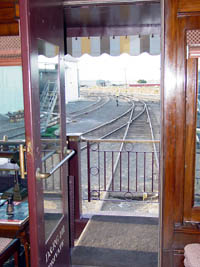Forty years after President Lincoln opened the West by signing the original Transcontinental Railroad Bill, his son Robert Todd Lincoln, as president of the Pullman Company, opened a new eara in rail car construction. Robert Lincoln led the giant passenger car manufacturer in the technological revolution from sixty foot wood-trussed varnished cars to eighty foot riveted steel;
from gas lighting to 32 volt DC electricity and from fabricated wood and iron trucks to massive steel castings. The most noticeable change was from the ornate Victorian interior to the era of simple elegance using clear wood and Mission style molding lightly accented with bronze hardware.
This car, delivered to the Denver and Rio Grande Railroad in 1910, was the culmination of these improvements and was typical of the ultimate in travel prior to World War I. After the decrease in movement to the “Wild West”, the coach was retired and rebuilt the railroad into a self-contained private business car. It expressed wealth, yet conservativeness: practicality yet opulence. The interior, done in satin walnut, consists of two double staterooms, a parlor room just off the observation platform, the secretary’s living quarters and office, dining room seating eight, living quarters for two porters, two fully tiled lavatories and a complete kitchen. It was the pride and status symbol of the D&RGW Railroad, but within two weeks of it’s completion the stock market collapse of 1929 abruptly ended the private car era.
The Abraham Lincoln has been preserved for close to a century looking much the same as most private cars of the early 1900's. It’s antiquated elegance is rare among surviving cars. It is listed on the Washington State Historical Registry. It is the oldest car acceptable to Amtrack in the United States.
This story starts about 25 years ago when Sandy and I were big dreamers. We went to an Amtrack sale of passenger rolling stock in Los Angeles. One of the cars offered was a Denver and Rio Grande business car which completely captured our hearts and imagination. It needed major work to bring it up to Amtrack Standards and the new owner was required to move it within 30 days. Totally naive about private car ownership and the unknowns we would be facing, we got cold feet and went home empty handed. Not buying the car has plagued me ever since.
When Arne and Morgan began planning their railbike vacation, I asked John VanDerven to join us. John told me he had a friend who had a private car in Othello, Washington (where we would be riding the old Milwaukee Road) and asked if I would like to see it. I told him the story of my close encounter with a business car and described the car to him. To our mutual amazement, the description fit his friend’s car exactly. I wasn’t sure wether I was up emotionally to seeing my lost love, and while I was procrastinating John wrote again saying we had been invited to stay aboard the car for two nights. It was impossible to resist the invitation.
.
 | ||||
Two Nights Aboard The
Abraham Lincoln
by Peter Hoffman
This story starts about 25 years ago when Sandy and I were big dreamers. We went to a sale of older passenger cars in Los Angeles. One of the cars was a Denver and Rio Grande business car. It captured our hearts and imagination completely. The car needed major work to bring it up to Amtrack standards and we would have to move it within 30 days. Totally naive about private car ownership and the unknown improvements we would be facing, which were well beyond my handyman abilities, we got cold feet and sadly went home empty handed. Not buying the car has plagued me ever since.
When Arne and Morgan began planning their railbike vacation, I asked John Vander Ven to join
us. John told me he had a friend who had a private car in Othello, Washington, where we would be riding the old Milwaukee Road, and asked if I would like to see it. I told him about the car we almost bought and described it to him. To our mutual amazement, my description fit his friend’s car exactly. I wasn’t sure whether I was emotionally up to seeing my lost love, and while I was procrasinating, John wrote again and said we had been invited to stay aboard the car for two nights. It was an offer I couldn't refuse, and I'm most happy I didn't.
Forty years after President Lincoln opened the West by signing the original Transcontinental Railroad Bill, his son Robert Todd Lincoln, as president of the Pullman Company, opened a new era in rail car construction. Robert Lincoln led the giant passenger car manufacturer in the technological revolution from sixty foot wood-trussed varnished cars to eighty foot riveted steel; from gas lighting to 32 volt DC electricity and from fabricated wood and iron trucks to massive steel castings. The most noticeable change was from the ornate Victorian interior to the era of simple elegance using clear wood and Mission style molding lightly accented with bronze hardware.
This car, delivered to the Denver and Rio Grande Railroad in 1910, was the culmination of these improvements and was typical of the ultimate in travel prior to World War I. After the decrease in movement to the “Wild West”, the coach was retired and rebuilt by the railroad into a self-contained private business car. It expressed wealth, yet conservativeness: practicality yet opulence. The interior, done in satin walnut, consists of two double staterooms, a parlor room just off the observation platform, the secretary’s living quarters and office, dining room seating eight, living quarters for two porters, two fully tiled lavatories and a complete kitchen. It was the pride and status symbol of the D&RGW Railroad, but within two weeks of it’s completion the stock market collapse of 1929 abruptly ended the private car era.
The Abraham Lincoln has been preserved for close to a century looking much the same as most private cars of the early 1900's. It’s antiquated elegance is rare among surviving cars. It is listed on the Washington State Historical Registry. It is the oldest car acceptable to Amtrack in the United States.
Our very kind and magnanimous hosts were Curt and Kim Andrews. Not only did they put us up for two nights in pure historic opulence, they stocked the refrigerator with food and drink! And if that wasn’t enough, Curt’s dad, Clyde, provided us with a last minute barbeque diner after showing us his collection of WW II military vehicles - and letting us drive them around his beautiful property.
Kurt, when still single, had originally bought the car to live in, but when he discovered Amtrack would haul it on the back of their trains, he set about to bring it up to their modern standards. This turned out to be
an immense undertaking, taking more than 18 years to accomplish. Both ends of the car had to be cut back 10 feet in order to install structural steel “crash supports”. The couplers needed changing and much of the understructure at both ends needed reinforcing. Amtrack ruled the truck castings were too old, and Curt bought a hospital car just to get the newer trucks. Many of the rivets that hold the sheet metal siding to the framework had rusted at the studs and had to be replaced. All of interior woodwork
was removed, numbered, and reinstalled in order to replace all the old electrical wiring, plumbing, and insulation and to make repairs to the walls. Most of the lamps and chandeliers were missing, and new fixtures were designed and cast out of bronze for the entire car. Clyde, who was actively farming during the early restoration period, said two of his welders worked on the car for the better part of one year. Then, of course, there was painting, carpeting, upholstering, and the appropriate furnishings to complete the restoration. I’m sure I have left out much of the work that was necessary. But the end result is truly magnificent.
The Observation Room at the end of the car has been painstakingly restored and appointed.
Stateroom A, my room for the night. Stateroom B is similar, but the bed direction is turned across the rails.
The Dining Room (only half seen here) has a built-in China cupboard with leaded glass door and mirrored sideboard. Because it occuppies the full width of the car, it feels quite spacious.
John and Arne enjoy the cocktail
hour in the Observation Room, a
delightful end to a day of railbiking.
View out the rear over the obser-
vation platform. Trains passed us
on the mainline to the right.
 | ||||||
After seeing the"Abraham Lincoln" and learning of the incredible amount of labor and resources it's restoration required, my emotional longings have greatly abated. I couldn't be happier that Curt and his family ultimately became the car's owners, for I doubt if there are many who would have done such a magnificant job of restoring this historical treasure.
Historical background provided by Curt Andrews
